Cross-addiction involves the addiction to more than one addictive behavior. It's also called addiction transfer, simultaneous addiction, and addiction interaction disorder. It can involve substances, such as alcohol and drugs, or compulsive behaviors, like gambling or sex. The causes vary from dopamine deficiencies to unresolved mental health issues. The first step to helping people out of this situation, including yourself if applicable, is to become educated about the issue.
Here are 5 startling facts and statistics about cross-addiction to do just that.
1. More Than 20 Million Adults Suffer From Substance Use Disorders (SUDs)
Amongst this population, at least 9% of them experience cross-addiction. It's important to realize the prevalence of SUDs and alcohol use disorders (AUDs) to understand how common cross-addiction. Cross-addiction often occurs when a person stops one addiction and picks up another in its place. This frequently happens in the recovery or healing process when quitting an addictive activity.
2. 40-60% of the Population Relapses Within 6 Months of Addiction Treatment
While it's an unfortunate number, this statistic shows how addiction goes beyond an individual's choice alone. Brain chemistry causes people to go back on something they really care about -- recovery.
Relapse may include going back to the same activity or becoming equally addicted to another one. Why does this happen? As previously stated, we can look towards brain chemistry to understand this occurrence.
3. Dopamine Dysregulation In the Limbic System Causes the Brain an Inability to Differentiate Between Addictive Substances
To put it simply, your brain responds to hormones and chemical processes. Addictions work with your reward system, which involves increased dopamine levels in response to the addictive stimulant (whether a substance or an activity).
So, your brain doesn't really make the distinction between one thing increasing dopamine or another -- it's just an increase, and it wants more.
This is often seen with AUDs.
4. People With AUDs are 18x More Likely to Abuse Opioids
Again, we see this trend of co-occurring addictions with alcohol and opioids. The brain doesn't make the difference between the two, as they are both increasing pleasure from the reward system.
This is why a person who wants to recover should avoid substances or activities that may become an addiction. If an individual has an AUD, they should inform their doctor so they can avoid potentially addictive prescriptions.
All of this information may seem like cross-addiction is a hopeless disorder. That isn't the case, however. It's something to be aware of so that you can take precautions to keep yourself on the path of recovery.
5. Coping Strategies, Skills, and Motivation Can Keep You From Developing a Cross-Addiction
Through education and awareness, you can avoid cross-addictions by taking the proper precautions.
This involves learning what you can about risks associated with addiction, informing those in your life of your struggles, and being honest with yourself about addictive behavior.
Lean On Support Systems
Whether you have a cross-addiction or not, you should be aware of the risks of falling into another addiction if you have one. The best way to conquer this problem is to work with a team. Having a support group that includes peers and professionals will help keep you on track and reduce the chances of developing or relapsing into cross-addiction.
We can be that for you. Contact us today to create your support system and keep reading our blog to educate yourself about addiction.








COMMENTS